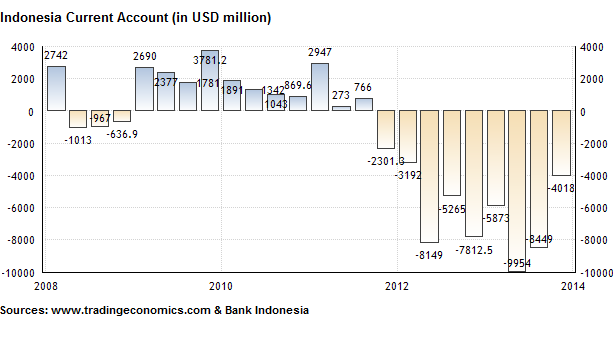Central Bank of Indonesia Expected to Keep its Key Interest Rate at 7.50%
 Indonesia's benchmark interest rate (BI rate) is expected to be maintained at 7.50 percent at Bank Indonesia's Board of Governor's Meeting on Tuesday 8 April 2014. Despite Indonesia's moderating inflation rate (7.32 percent year on year in March 2014) and the February 2014 trade surplus of USD $785 million, the BI rate may be left unchanged in order to support the further easing of Indonesia's current account deficit and to offset the impact of the possible US interest rate hikes in 2015 and 2016.
Indonesia's benchmark interest rate (BI rate) is expected to be maintained at 7.50 percent at Bank Indonesia's Board of Governor's Meeting on Tuesday 8 April 2014. Despite Indonesia's moderating inflation rate (7.32 percent year on year in March 2014) and the February 2014 trade surplus of USD $785 million, the BI rate may be left unchanged in order to support the further easing of Indonesia's current account deficit and to offset the impact of the possible US interest rate hikes in 2015 and 2016.
The deposit facility rate (FASBI) and lending facility rate are also expected to be left unchanged at 5.75 and 7.50 percent respectively.
Bank Indonesia aims to curb the country's current account deficit to a maximum of 2.5 percent of GDP, a figure which is assessed as sustainable. The current account deficit hit a record high at USD $9.9 billion (or 4.4 percent of GDP) in the second quarter of 2013 caused by a significant deficit in the country's oil and gas sector in combination with robust domestic demand and low commodity prices. However, from the third quarter of 2013, the deficit started to improve due to sharp rupiah depreciation (making imports cheaper and exports more expensive), slightly improved global conditions and several government policies aimed at curbing imports while stimulating exports (for example the reduction in fuel subsidies in June 2013). In the fourth quarter of 2013, the current account deficit had eased to USD $4.0 billion (or 1.98 percent of GDP). Overall, the current account recorded a deficit of USD $28.5 billion, equivalent to 3.3 percent of GDP, in 2013.

Global concern about Indonesia's current account was the primary reason that international investors pulled billions of US dollars from Indonesia's capital markets between May and December 2013 amid a period of high uncertainty as the US Federal Reserve started to speculate about an end to its massive monthly bond-buying program (quantitative easing).
The BI rate had been raised from 5.75 percent in June 2013 to 7.50 percent in November 2013 in an effort to combat high inflation (after the government raised prices of subsidized fuel in June 2013), as well as to support the rupiah rate and current account.
Benchmark Interest Rate of Indonesia (BI Rate), 2008-2013:
| 2008 | 2009 | 2010 | 2011 | 2012 | 2013 | |
| Bank Indonesia Rate (percent at year-end) |
9.25 | 6.50 | 6.50 | 6.00 | 5.75 | 7.50 |
Source: Bank Indonesia


